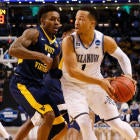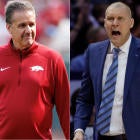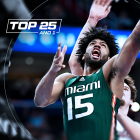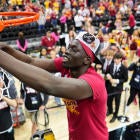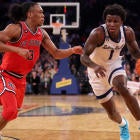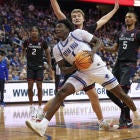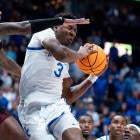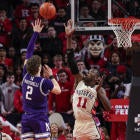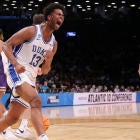There's still time to win! Pick the Final Four winners in CBS Sports' Round-By-Round game and you could be in attendance next year.
Much has been made of Villanova's vaunted offense this season, and for good reason: Jay Wright's team has some of the most remarkable offensive statistics we've ever seen.
The Wildcats rank second in the nation in effective field goal percentage. The team rarely turns the ball over; its 15 percent turnover rate ranks 14th in the country. The team shoots an enormous amount of 3-pointers– nearly 40 percent of its points come from 3-pointers – yet does so efficiently: Villanova's 40 percent 3-point percentage ranks 15th in the nation. So just a perimeter-focused team? Hardly. Villanova's 2-point percentage is 58.8 percent, third in the nation. Watching point guard Jalen Brunson back down bigger players in the post is something to behold.
But the most impressive offensive statistic of all is this one: Villanova scores 127.3 points per 100 possessions. That's not just the best rate in college basketball this season; it's nearly five points per 100 possessions better than the second-place team, Purdue.
In fact, it's the second-best offensive efficiency rating since the web site KenPom.com began tracking efficiency numbers in the 2001-02 season.
So which was the team that had a more efficient offense over the past 17 seasons than Villanova's offense this season?
"They used to tell me it was us," former Wisconsin coach Bo Ryan said this week when I called him up at his vacation home in La Quinta, Calif.
And it still is. The 2014-15 Wisconsin team that ended Kentucky's bid for perfection before losing to Duke in the national title game was the most prolific offense in the KenPom era, averaging an absurd 129.0 points per 100 possessions.
The two teams' rosters are different. Villanova is perimeter-focused, having five players at all times who can put the ball on the floor and can shoot the three. Wisconsin's offense ran through two big men who'd soon become first-round picks, Frank Kaminsky and Sam Dekker. Those Badgers scored efficiently from all over the floor, but that wasn't what made Ryan so proud of this team.
"The stat I really liked," he said, "was that for so many years we led college basketball with the fewest turnovers."
That was the case in 2014-15, too.
How are these two offensive juggernauts similar?
"I look at this Nova team and our team from 2014-15, and yeah, they are very similar," said Ryan, who retired in 2015. "When they talk about the extra pass, our teams have done a lot of shot fake, ball fake, making the pass that leads to the pass. When it comes to assists, I've been arguing this for decades to count the extra assist that leads to a bucket. It's so obvious with certain teams that it's not just one drive and a kick that leads to a shot, but a drive and a kick and a kick. Or a drive and a kick and a cross-court pass. That was us, and that's Nova too."
And another similarity between these two teams in a college basketball era dominated by transfers and one-and-dones: Both of these teams had the majority of its players – in Wisconsin's case, its entire roster – grow up together in the same system. Villanova has one transfer, Eric Paschall; he has been with the team during the national championship season in 2015-16, when he was redshirting after transferring from Fordham.
"This was a team that came in right from the beginning and every guy was committed to our program and stayed together," Ryan said. "Same with Nova. The reason that team was so good, No. 1, they developed their individual talents, which became better as a team by utilizing those individual talents. But they enjoyed playing with one another, and they played off of one another. That's how you get the special teams. When we were winning national titles in D-III we didn't out-athlete anybody, but we had a lot of really solid guys who played together, who moved the ball, who rotated on defense. Each guy had the other guy's back."
That sounds a lot like this Villanova team.
Neither team was exactly bereft of big-time talent. Dekker was highly regarded coming into school as a top-20 recruit. Kaminsky wasn't, but he developed into a national player of the year by his senior season and became a lottery pick. A few others have been bouncing around the G League.
Villanova has a surefire future lottery pick in redshirt junior Mikal Bridges. Jalen Brunson is going to be an effective NBA player for a long time. And don't be surprised if Omari Spellman and Donte DiVincenzo find a spot in the NBA as well.
Ryan admits he's a little prejudiced for Villanova. He's a Philly huy, a diehard 76ers, Eagles and Phillies fan. He grew up not far from Villanova's campus. He took some graduate credits there. But all season, strictly from a basketball perspective, Villanova was one of his favorite teams to watch play, along with Virginia and Loyola-Chicago, who Villanova could potentially meet in the title game.
"Villanova just plays," Ryan said. "Especially Brunson and the way he runs things. Whenever there's a mistake made by a player, whether he made it or somebody else, he always claps and has this look on his face: 'OK, we'll get the next one.' That's what I want in my point guard."












